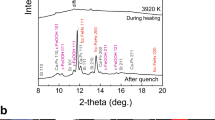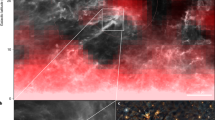Abstract
On the basis of geophysical observations, cosmochemical constraints, and high-pressure experimental data, the Earth’s liquid outer core consists of mainly liquid iron alloyed with about ten per cent (by weight) of light elements1,2. Although the concentrations of the light elements are small, they nevertheless affect the Earth’s core: its rate of cooling, the growth of the inner core, the dynamics of core convection, and the evolution of the geodynamo3,4. Several light elements—including sulphur, oxygen, silicon, carbon and hydrogen—have been suggested2, but the precise identity of the light elements in the Earth’s core is still unclear. Oxygen has been proposed as a major light element in the core on the basis of cosmochemical arguments and chemical reactions during accretion5,6. Its presence in the core has direct implications for Earth accretion conditions of oxidation state, pressure and temperature. Here we report new shockwave data in the Fe–S–O system that are directly applicable to the outer core. The data include both density and sound velocity measurements, which we compare with the observed density and velocity profiles of the liquid outer core. The results show that we can rule out oxygen as a major light element in the liquid outer core because adding oxygen into liquid iron would not reproduce simultaneously the observed density and sound velocity profiles of the outer core. An oxygen-depleted core would imply a more reduced environment during early Earth accretion.
This is a preview of subscription content, access via your institution
Access options
Subscribe to this journal
Receive 51 print issues and online access
$199.00 per year
only $3.90 per issue
Buy this article
- Purchase on Springer Link
- Instant access to full article PDF
Prices may be subject to local taxes which are calculated during checkout



Similar content being viewed by others
References
Birch, F. Density and composition of mantle and core. J. Geophys. Res. 69, 4377–4388 (1964)
Li, J. & Fei, Y. in Treatise on Geochemistry (2007 update) (ed. Carlson, R. W. ) Vol. 2, 1–31 (Elsevier, 2007)
Hillgren, V. J., Gessmann, C. K. & Li, J. in Origin of the Earth and the Moon (eds Canup, R. M. & Righter, K. ) 245–263 (Arizona Univ. Press, 2000)
Buffett, B. A. Earth’s core and the geodynamo. Science 288, 2007–2012 (2000)
Ringwood, A. E. Composition of the core and implications for origin of the earth. Geochem. J. 11, 111–135 (1977)
Ohtani, E. & Ringwood, A. E. Composition of the core. I. Solubility of oxygen in molten iron at high temperatures. Earth Planet. Sci. Lett. 71, 85–93 (1984)
Alfè, D., Gillan, M. J. & Price, G. D. Composition and temperature of the Earth’s core constrained by combining ab initio calculations and seismic data. Earth Planet. Sci. Lett. 195, 91–98 (2002)
Helffrich, G. & Kaneshima, S. Seismological constraints on core composition from Fe-O-S liquid immiscibility. Science 306, 2239–2242 (2004)
Mitchell, A. C. & Nellis, W. J. Shock compression of aluminum, copper, and tantalum. J. Appl. Phys. 52, 3363–3374 (1981)
Huang, H. J., Jing, F. Q. & Cai, L. C. Studies of the Hugoniot curve for Fe/FeO/FeS mixture. Chinese J. High Press. Phys. [in Chinese]. 20, 139–144 (2006)
Brown, J. M., Fritz, J. N. & Hixson, R. S. Hugoniot data for iron. J. Appl. Phys. 88, 5496–5498 (2000)
Brown, J. M., Ahrens, T. J. & Shampine, D. L. Hugoniot data for pyrrhotite and the Earth’s core. J. Geophys. Res. 89, 6041–6048 (1984)
Ahrens, T. Equations of state of iron sulfide and constraints on the sulfur content of the Earth. J. Geophys. Res. 84, 985–998 (1979)
Yagi, T., Fukuoka, K., Takei, H. & Syono, Y. Shock compression of wüstite. Geophys. Res. Lett. 15, 816–819 (1988)
Jeanloz, R. & Ahrens, T. J. Equation of state of FeO and CaO. Geophys. J. R. Astron. Soc. 62, 505–528 (1980)
Duffy, T. & Ahrens, T. J. Compressional sound velocity, equation of state, and constitutive response of shock-compressed magnesium oxide. J. Geophys. Res. 100, 529–542 (1995)
Hu, J., Zhou, X., Tan, H., Li, J. & Dai, C. Successive phase transitions of tin under shock compression. Appl. Phys. Lett. 92, 111905 (2008)
Huang, H. et al. Melting behavior of Fe-O-S at high pressure: a discussion on the melting depression induced by O and S. J. Geophys. Res. 115, B05207 (2010)
Brown, J. M. & McQueen, R. G. Phase transitions, Gruneisen parameter, and elasticity for shocked iron between 77 GPa and 400 GPa. J. Geophys. Res. 91, 7485–7494 (1986)
Nguyen, J. H. & Holmes, N. C. Melting of iron at the physical conditions of the Earth’s core. Nature 427, 339–342 (2004)
Mao, H. K. et al. Phonon density of states of iron up to 153 Gigapascals. Science 292, 914–916 (2001)
Lin, J. F. et al. Sound velocities of hot dense iron: Birch's law revisited. Science 308, 1892–1894 (2005)
Jing, F. Q. Introduction to Experimental Equation of State [in Chinese] 1–371 (Scientific Press, 1986)
Dziewonski, A. D. & Anderson, D. L. Preliminary reference Earth model. Phys. Earth Planet. Inter. 25, 297–356 (1981)
Wallace, D. C. Entropy of liquid metals. Proc. R. Soc. Lond. A 433, 615–630 (1991)
Komabayashi, T. & Fei, Y. Internally consistent thermodynamic database for iron to the Earth’s core conditions. J. Geophys. Res. 115, B03202 (2010)
McDonough, W. F. & Sun, S.-s. The composition of the Earth. Chem. Geol. 120, 223–253 (1995)
Wood, B. J., Wade, J. & Kilburn, M. R. Core formation and the oxidation state of the Earth: additional constraints from Nb, V and Cr partitioning. Geochim. Cosmochim. Acta 72, 1415–1426 (2008)
Rubie, D. C. et al. Heterogeneous accretion, composition and core–mantle differentiation of the Earth. Earth Planet. Sci. Lett. 301, 31–42 (2011)
Weng, J. et al. Optical-fiber interferometer for velocity measurements with picosecond resolution. Appl. Phys. Lett. 89, 111101 (2006)
Acknowledgements
We thank C. D. Dai, J. D. Weng and Q. S. Wang from the Institute of Fluid Physics for help with the experiments, and Q. Shen from the Sate Key Lab of Advanced Technology for Materials Synthesis and Processing and C. H. Shen from the Materials Research and Testing Center for the preparation of the samples. We also thank C. Seagle, L. Zhang and V. Hillgren for comments. This work was supported by the National Natural Science Foundation of China (grant numbers 41074056 and 40604007), the Fundamental Research Funds for the Central Universities, and the National Basic Research of China (grant number 2010CB731600). Support by the National Science Foundation (grant number EAR-0809539 to Y.F.) and the Carnegie Institution of Washington is also acknowledged.
Author information
Authors and Affiliations
Contributions
H.H. and Y.F. designed the study, analysed the data and wrote the manuscript. H.H. and X.H. conducted the experiments. L.C. made arrangements and preparations for the experiments. F.J., H.X., L.Z. and Z.G. contributed to discussions and made suggestions for the experiments.
Corresponding author
Ethics declarations
Competing interests
The authors declare no competing financial interests.
Supplementary information
Supplementary Figures
This file contains Supplementary Figures 1-6 with legends. (PDF 601 kb)
Rights and permissions
About this article
Cite this article
Huang, H., Fei, Y., Cai, L. et al. Evidence for an oxygen-depleted liquid outer core of the Earth. Nature 479, 513–516 (2011). https://doi.org/10.1038/nature10621
Received:
Accepted:
Published:
Issue Date:
DOI: https://doi.org/10.1038/nature10621
This article is cited by
-
Evidence for a liquid silicate layer atop the Martian core
Nature (2023)
-
Inner core composition paradox revealed by sound velocities of Fe and Fe-Si alloy
Nature Communications (2022)
-
Early planetary processes and light elements in iron-dominated cores
Acta Geochimica (2022)
-
Earth’s core could be the largest terrestrial carbon reservoir
Communications Earth & Environment (2021)
-
Stability and anisotropy of (FexNi1−x)2O under high pressure and implications in Earth’s and super-Earths’ core
Scientific Reports (2018)
Comments
By submitting a comment you agree to abide by our Terms and Community Guidelines. If you find something abusive or that does not comply with our terms or guidelines please flag it as inappropriate.



